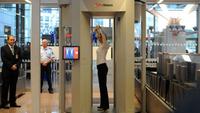-
Better policies needed to reduce radiation exposure in nuclear accidents
A new study says that offsite policies and plans should be put in place to reduce the exposure of the public to radiation in the event of a nuclear power plant accident
-
-
New radiation sensor developed
Scientists have created one of the most advanced radiation sensors in the world: an X-ray detector that can reveal the composition of materials in a fraction of a second
-
-
DHS report concludes airport scanners are safe

A new report by the DHS Inspector General concludes that the Transportation Security Administration’s (TSA) full body scanners are safe; the IG reviewed five independent studies and concluded that an airline passenger would have to be subjected to 17,000 screenings a year, or forty-seven a day, to reach the limit of acceptable radiation dosing
-
-
U.S. helps Ukraine detect dirty bombs at Euro 2012 tournament
In advance of the Euro 2012 soccer tournament in Ukraine, security officials are stocking up on radiation detectors due to growing concerns of a dirty bomb attack during the event
-
-
Universal Detection developing smartphone radiation scanner for food
In the wake of Japan’s nuclear disaster at the Fukushima Daiichi atomic energy plant, concerns over contaminated food supplies have swept the nation, sparking Universal Detection Technology to develop a smartphone radiation detector specifically designed for comestibles
-
-
Nuclear accident reawakens California’s anti-nuke movement
Following the discovery of a small leak at a nuclear power plant near San Diego, California in January, the state’s anti-nuclear movement has hit a fever pitch
-
-
Fukushima accident caused only low levels of fallout in U.S.
Fallout from the 2011 Fukushima Dai-ichi nuclear power facility in Japan was measured in minimal amounts in precipitation in the United States in about 20 percent of 167 sites
-
-
Growing ubiquity of X-ray scanners could pose public health risk
Body scanners are now routinely deployed in airports, border check points, and even the streets of some American cities; with the use of X-ray scanners by law enforcement agencies becoming increasingly commonplace, health advocates worry that the additional radiation exposure could pose a health risk; repeated exposures to low-doses of radiation can lead to cancer; currently federal health standards are primarily limited to medical X-rays and since the body scanners do not fall under this category, the decision on where and how to use the devices is entirely up to security officials
-
-
Illinois first responder receive wearable radiation detectors
First responder across Illinois will soon be outfitted with portable personal radiation detectors to detect dirty bombs and increase safety
-
-
New material removes radioactive gas from spent nuclear fuel
Worldwide efforts to produce clean, safe nuclear energy and reduce radioactive waste are aided by researchers who showed that metal-organic frameworks (MOFs) can be used to capture and remove volatile radioactive gas from spent nuclear fuel
-
-
Schafer in $40 million DNDO contract
The Schafer Corporation has started work on a $40 million contract for the DHS Domestic Nuclear Detection Office (DNDO) to provide Systems Engineering and Technical Assistance (SETA) support services
-
-
Scientists study how nature cleans uranium from aquifer
A small town in Colorado was the site of uranium ore processing in the 1940s and 1950s, producing yellowcake; when the mills shut down, the mill tailings — a crushed rock byproduct of ore processing — were left behind on the north bank of the river; the tailings were hauled away in the 1990s, but a large amount of uranium that seeped out of the tailings remains as a contaminant in the aquifer and is slowly being released into the Colorado River
-
-
RMD awarded $3.65 million in government funding for nuclear detection research
Last week RMD Research was awarded two contracts worth $3.65 million total by DHS’ Domestic Nuclear Detection Office to develop gamma and neutron radiation detectors
-
-
Decontaminating radiation-laced water at Fukushima Daiichi
Thanks to special radiation devices, made by UOP LLC, a Honeywell company, cleanup crews in Japan have been able to treat five million gallons of water contaminated by radiation at the Fukushima Daiichi nuclear power plant
-
-
Study promises possible therapy for radiation sickness
Studies of potential radiation therapies suggest they would be effective in humans only if administered within a few minutes or hours of radiation exposure, thus making them impractical for use in response to events involving mass casualties; the larger time window for administering a new 2-drug regimen ofeers the prospect that it could become a mainstay of the response to public health threats such as a nuclear power plant accident or nuclear terror attack
-
- All
- Regional
- Water
- Biometrics
- Borders/Immig
- Business
- Cybersecurity
- Detection
- Disasters
- Government
- Infrastructure
- International
- Public health
- Public Safety
- Communication interoperabillity
- Emergency services
- Emergency medical services
- Fire
- First response
- IEDs
- Law Enforcement
- Law Enforcement Technology
- Military technology
- Nonlethal weapons
- Nuclear weapons
- Personal protection equipment
- Police
- Notification /alert systems
- Situational awareness
- Weapons systems
- Sci-Tech
- Sector Reports
- Surveillance
- Transportation
Advertising & Marketing: advertise@newswirepubs.com
Editorial: editor@newswirepubs.com
General: info@newswirepubs.com
2010-2011 © News Wire Publications, LLC News Wire Publications, LLC
220 Old Country Road | Suite 200 | Mineola | New York | 11501
Permissions and Policies
Editorial: editor@newswirepubs.com
General: info@newswirepubs.com
2010-2011 © News Wire Publications, LLC News Wire Publications, LLC
220 Old Country Road | Suite 200 | Mineola | New York | 11501
Permissions and Policies
